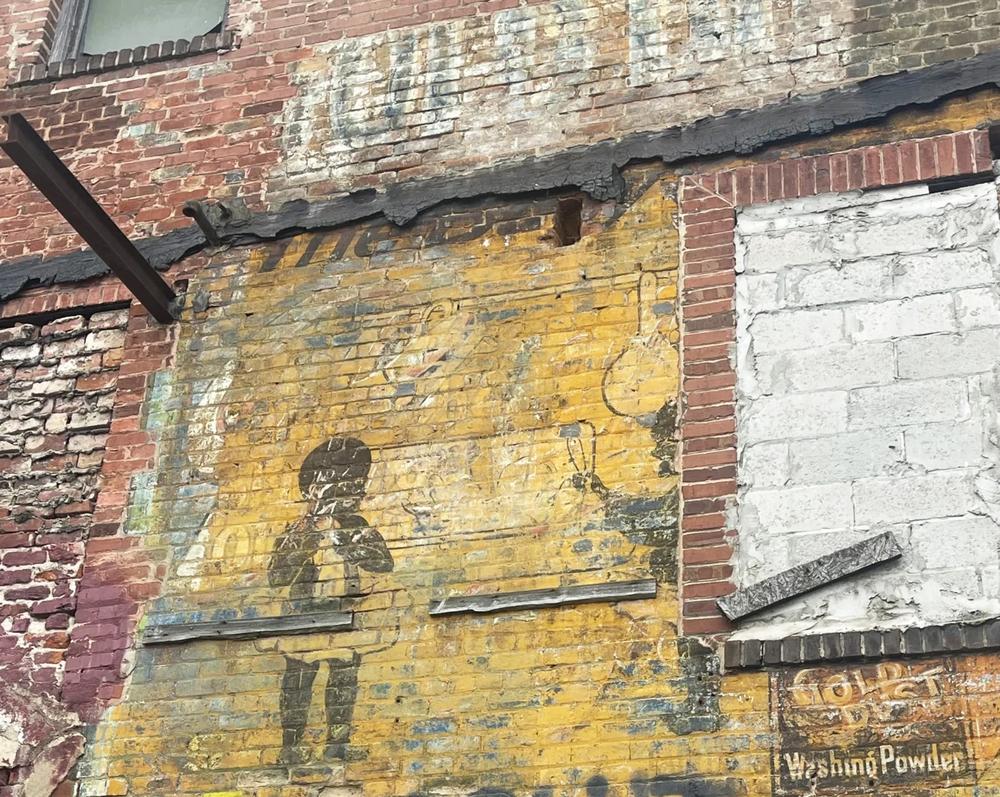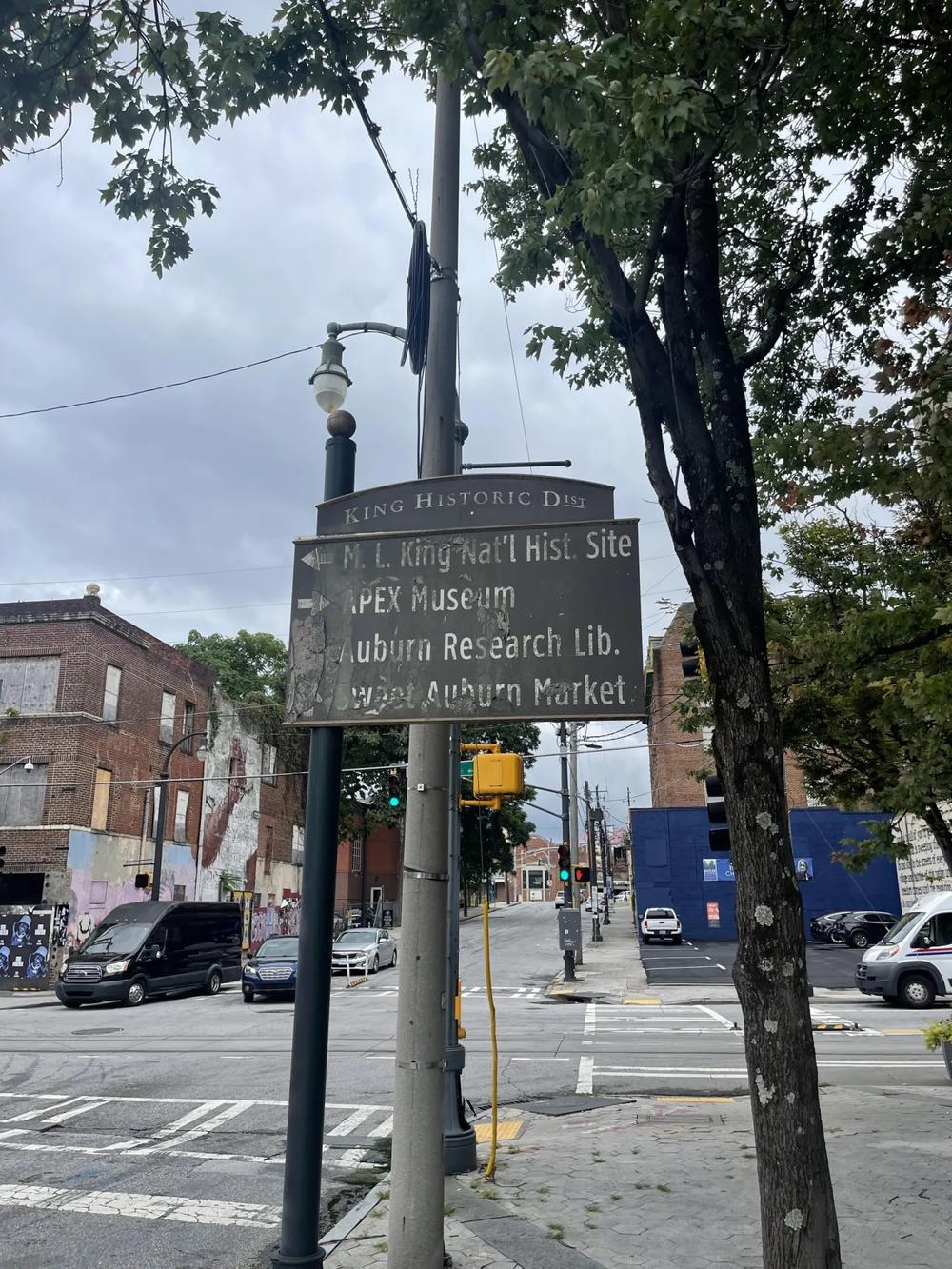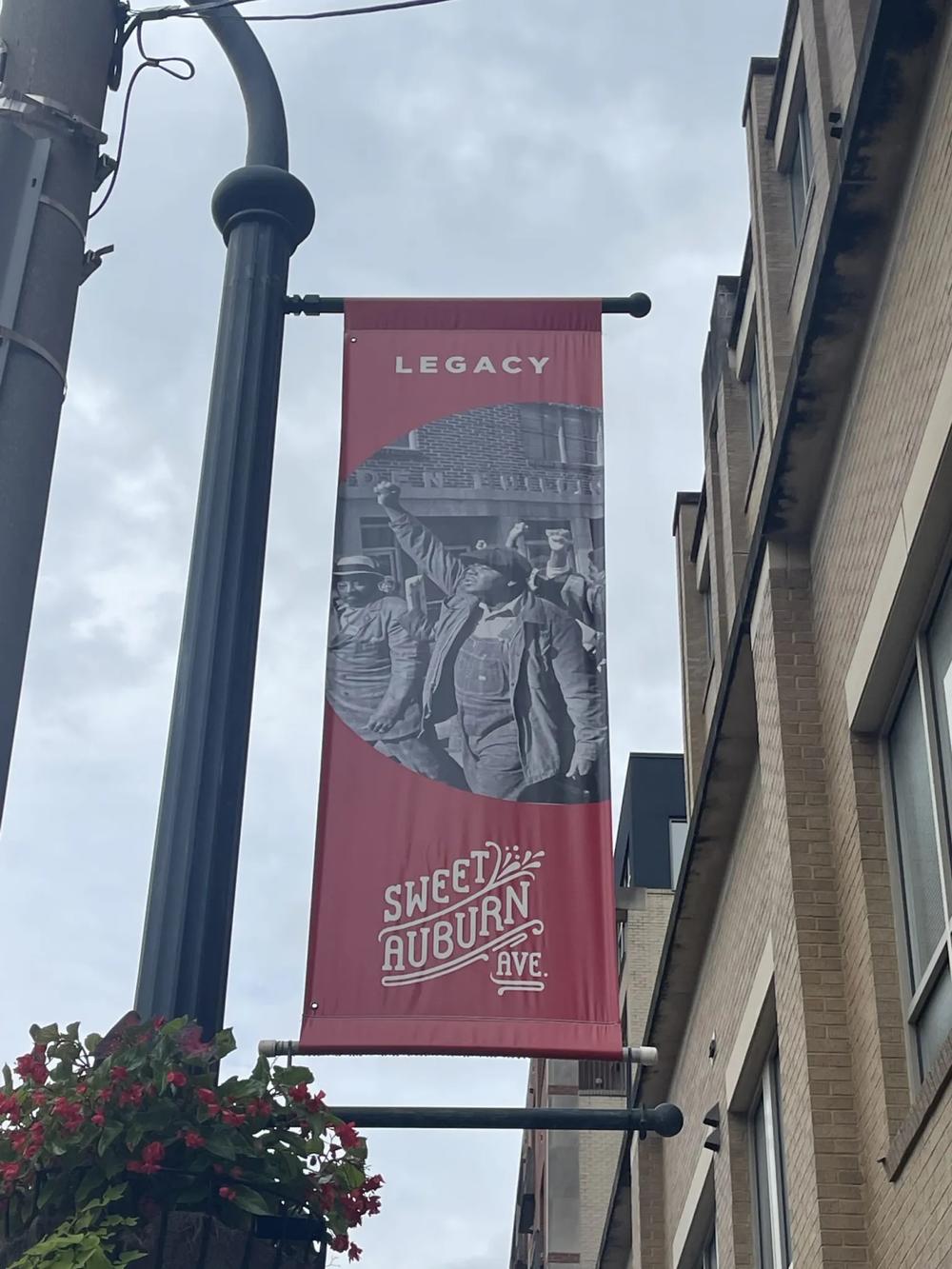
Caption
An advertisement for Gold Dust washing powder from the mid-1950s to early 1960s is still visible on an exterior wall of 229 Auburn Avenue.
Credit: Donnell Suggs/The Atlanta Voice
Through graffiti and cracked glass it’s hard to read the signage above the door at 229 Auburn Avenue. The gray clouds and rain on a Friday afternoon in mid-August don’t help either. The original location of the Atlanta State Savings Bank, the first chartered, Black-owned bank in the state of Georgia, is now a shell of itself. Literally, the building is a shell; hard on the outside with a hidden interior that will only reveal itself once it is cracked open. Unlike cracking an egg, any restoration and renovation efforts will not be simple and cost a lot more money.
Located at the corner of Jesse Hill Jr. Drive and Auburn Avenue, in the heart of the Sweet Auburn District, once known as the richest stretch of Black real estate in America, the three-story building is boarded up and has been that way for decades. Concert posters and advertisements for upcoming rap albums litter the exterior walls.
Also the home of The Atlanta Life Insurance Company, once a beacon of self-respect and security during a time when neither was a sure thing for Blacks in the South, is now an overlooked piece of property that could really use some tender loving care, according to Atlanta Preservation Center Executive Director David Yoakley Mitchell. “Here is a cornerstone of Atlanta’s history,” Mitchell said. “The bank was a catalyst for people to have some semblance of economic freedom.”
Built in the early 1900s, the Atlanta brand of The Atlanta Life Insurance Co. occupied a corner lot in what was the business hub of Black Atlanta. These days there is very little business taking place on that side of the street while a new apartment project, a vegan breakfast bar and a bakery exist in the shadow of 229 Auburn.
There is development taking place on Auburn Avenue, just not at 229 Auburn, at least for now. Development pressure can lead to the property, more specifically the land the property occupies, being sold to the highest bidder much like lots in the Reynoldstown, Summerhill and Grove Park neighborhoods, for example.
There won’t be a Microsoft or Google coming to Auburn Avenue any time soon so the development of Atlanta’s most famous Black stretch of businesses will have to be improved piece by piece. But there isn’t much time. Nearly 50% of the Sweet Auburn District has lost its historic buildings, according to data provided by the National Parks Service.
The tornado that tore through downtown Atlanta 14 years ago left 229 Auburn at a disadvantage. It looks like a single tooth in a mouth hanging on for dear life. The Herndon Building was next door at 243 Auburn Avenue and took up a large portion of that lot. The hurricane helped speed up the lifespan of what was already a condemned and decaying property. 229 Auburn is all that’s left of that lot.

An advertisement for Gold Dust washing powder from the mid-1950s to early 1960s is still visible on an exterior wall of 229 Auburn Avenue.
A parking lot now occupies the majority of that space. An advertisement for Gold Dust washing powder on the side of the building is still visible in between the bricks. The gold paint has faded but not totally been washed away by time and neglect. In the ad a Black baby is shown holding a bottle while the arm of a woman reaches out with a cloth. The product was first introduced to the public in 1889. The fact that the ad was prominently displayed on 229 Auburn’s wall is a sign of the commerce the bank and insurance company was generating with the Black community that it served, said Mitchell.
Unbothered by the light rainfall, Mitchell leaned against a light pole on the corner while he spoke passionately of what the building at 229 Auburn means to the city’s story. “It’s not just a piece of Black history, it is a piece of Atlanta history,” he said. “As a resident of Atlanta we should protect our history.”
Mitchell reflected on the fact that he and a Black reporter from The Atlanta Voice would not have been able to have a conversation on the corner of Jesse Hill Jr. Drive and Auburn Avenue when the bank was first opened. In the shadow of the now famous Congressman John Lewis “Hero” mural, 229 Auburn, is a piece of history. Mitchell calls the building “a time capsule of some sort.”

A general view of Auburn Avenue is seen Friday, Aug. 19, 2022, in Atlanta, Ga.
Asked what he thinks the public can do to help the preservation efforts for properties like 229 Auburn and others, Mitchell said they can come down to Sweet Auburn and see it for themselves. “One, they can come here and see the property, touch the property and just feel the history,” he said. “Just because it isn’t breathing doesn’t mean it doesn’t deserve to live.”
Mitchell also suggests those that are interested in learning more can advocate for preservation and protection of historic properties by reaching out to The Atlanta Preservation Center and organizations like the Butler Street Community Development Corporation, an Atlanta-based community-focused organization that provides services for underserved youth and their families in the area and owns the property at 229 Auburn Avenue. The original structure that housed the Butler Street YMCA, once known as the “Black City Hall” due to its importance to the neighborhood, is just feet from 229 Auburn.
Currently valued at $606,700, according to Fulton County property records, 229 Auburn is one of the cheaper properties in the immediate area. In comparison, the property at 210 Auburn Avenue, Bethel Towers, is valued at $6.7 million, according to Fulton County property records. The land alone is valued at nearly $1.4 million, according to county records. 210 Auburn Avenue is across the street from 229, yet a world away in value and status.
An architect’s point of view is less about dollar signs and appreciated value. Dr. Danielle Willkens cares more about how the building was built and what it means for the Sweet Auburn District. During an interview with The Atlanta Voice, Willkens, an assistant professor at Georgia Tech’s School of Architecture, spoke of the origin of the building’s bricks. “As an architect we often talk about embodied energy,” Willkens said.

The King Historic District encompasses the majority of Auburn Avenue, including the birthplace of Dr. Martin Luther King Jr., which is only a few blocks away from 229 Auburn Avenue.
She also believes there’s an economic advantage in saving buildings. The less buildings we build, the less materials we use, the better. ”If we can save these structures, that’s the best job we can do as designers.”
Of the land the building occupies, Willkens calls the location, “a critical corner” and “if that building wasn’t there, its absence would be noted. It’s part of the rhythm of the street.”
University of Georgia English Professor and Wilson Center for Humanities & Arts Director Barbara McCaskill said 229 Auburn, “Is significant to Atlanta’s history in multiple ways. As the site of Atlanta State Savings Bank, it signals the prominence and prosperity of hard-working African American communities in spite of segregation’s violence and inequities,” she said.
The bank’s motto was once “safety and strength,” according to McCaskill. She found that motto very poignant considering what Lewis meant to millions of Americans. His mural is next door. “Together, both structures tell the story of how Atlanta’s Black community has been pivotal to the city and nation as a model for shaping spaces, initiatives, and neighborhoods where all can thrive.”
Mitchell doesn’t want Atlantans to forget about where the first Black bank once stood and what it stood for. “While it’s here we’re forced to remember it and that memory over time becomes a source of pride,” he said.

Legacy signage hangs from a street pole on Auburn Avenue, Friday, Aug. 19, 2022.
The Book of Proverbs 16:18 reads as follows: “Pride goeth before destruction, and a haughty spirit before a fall.” That oft-referenced Bible verse translates to mean that people who are overconfident are more likely to fail. There is nothing overly confident about the building at 229 Auburn. Its customers have long moved on to other banks, its doors have long been closed. 229 Auburn is defiant, strong and still standing at the corner of Atlanta’s Black history. For now.
“It is more important than ever to preserve the historic space at 229 Auburn Avenue,” said Sarah Borcherding, a graduate student in Georgia State University’s Master of Heritage Preservation Program. Borcherding is familiar with the property, she has completed a ArcGIS Storymaps project titled, “Saving 229 Auburn Avenue.” In it she speaks of the buildings past, present and future. “Once the tangible building is gone, it can be difficult to convey the history to our current and future generations.”
This story comes to GPB through a reporting partnership with The Atlanta Voice.